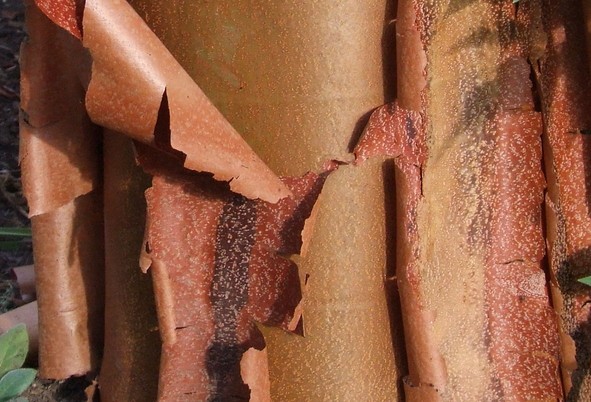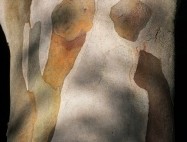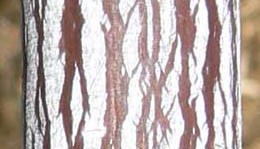 In winter when many trees have shed their leaves and the garden is sleeping, the beauty of bark can best be appreciated. Bark can provide color and texture that produces visual interest all winter and extends the pleasure that can be derived from the garden. Colors can range from white, to red, and to shades of brown while variations in textures include silky to rough. Some barks have interesting patterns while others exfoliage and are constantly changing. If you have never noticed how beautiful bark can be, you may be pleasantly surprised.
In winter when many trees have shed their leaves and the garden is sleeping, the beauty of bark can best be appreciated. Bark can provide color and texture that produces visual interest all winter and extends the pleasure that can be derived from the garden. Colors can range from white, to red, and to shades of brown while variations in textures include silky to rough. Some barks have interesting patterns while others exfoliage and are constantly changing. If you have never noticed how beautiful bark can be, you may be pleasantly surprised.
Here are five trees with outstanding bark for winter interest.
 Paperback Maple (Acer griseum)
Paperback Maple (Acer griseum)
A native of China, this small deciduous tree has cinnamon-brown bark that exfoliates in thin sheets. It grows slowly and has an upright, irregular oval form. As an added bonus, the fall coloration is often beautiful when the dark green leaves take on orange and red tones.
-
Size:20-30′ H x 15-25′ W
Site: Average, medium moist, well-drained. slightly acidic; full sun to part shade
Hardiness: Zones 4-8
 Himalyean White Birch (Betula utilis var. jacquemontii)
Himalyean White Birch (Betula utilis var. jacquemontii)
As the common name suggests this deciduous medium sized tree is native to cool weather and does not do well in heat and humidity. It is unsurpassed, however, for the whiteness of its bark. With yellow green leaves that turn golden in the fall, male and female catkins in spring, Himalayan birch offers long season interest.
-
Size:30-40′ H 18-25′ W
Site:Average, medium moist to wet; full sun to part shade
Hardiness: Zones 5-6
 Mountain Gum (Eucalyptus dairympleana)
Mountain Gum (Eucalyptus dairympleana)
This broadleaf evergreen tree is native to southeastern Australia and quickly grows into a tall columnar form, dropping its lower branches as it matures. The bluish green leaves are aromatic. The smooth white bark turns pink to light brown before peeling off the reveal new white bark beneath resulting in an exotic pattern of colors that resemble the skin of a python.
-
Size: 50-70′ H x 15-25′ W
Site: Average, dry to medium, acidic but tolerates alkalinty
Hardiness: Zones 8-10
 Paperbark Cherry (Prunus serrula)
Paperbark Cherry (Prunus serrula)
Although its beautiful display of flowers in spring attracts attention, the charm of this small deciduous tree starts in winter when its shiny red-brown bark marked by prominent horizontal lenticels that are clearly visible. A native of western China and Tibet, the tree is compact and has a rounded form. Unfortunately, it is susceptible to a large number of pests and diseases.
-
Size:20-30 H x 20-30 W
Site: Average, medium moist, well-drained; full sun to part shade
Hardiness: Zones 5-6
 Striped Maple (Acer pensylvanicum)
Striped Maple (Acer pensylvanicum)
This small deciduous tree is a native of eastern United States where it often grows and an understory tree in cool moist forests. Its young branches are striped longitudinally with white or green and resembles snakes skin, giving rise to the common name snakebark maple. The young stems of the cultivar ‘Erythrocladum’ turn red after leaf drop, adding to the winter interest. Fall coloration is a showy yellow.
-
Size: 20-30′ H x 20-30′ W
Site: Average, cool, moist, well-drained, slightly acidic soil; part shade
Hardiness: Zones 3-7